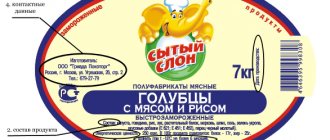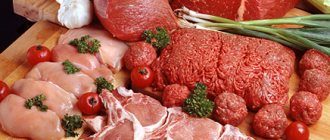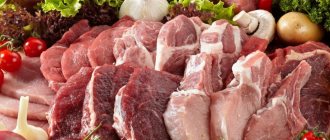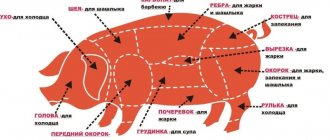You might think that sausages and sausages are no different except in size. However, the two methods for making meat delicacies are based on different methods. In the first case, minced meat is used for raw materials, in the second, minced meat. There is also a difference in the packaging method. If sausages are wrapped in a natural casing, then artificial casings are often chosen for sausages (with the exception of premium varieties).
Today we are giving a detailed answer to the questions: what are sausages made from, and is there any benefit from such a dish on your table? Looking ahead, we note that the high calorie content of the product plays a certain role, allowing you to quickly fill the energy deficit. Sausages contain elements that are beneficial to the body: proteins, magnesium, potassium, iron, sulfur, calcium, phosphorus, iodine, vitamins B1, B2, E and PP. But manufacturers also use carcinogens and other chemicals.
- Diabetes
- Pancreatitis
- Liver diseases
- Cholecystitis
- Gout
What does the product contain?
Meat is used as the main ingredient in production: pork, beef, and sometimes poultry. The benefit of sausages lies in their high protein content, but it is also worth considering the presence of additives: soy, starch, all kinds of cereals, spices, milk powder and often flavor enhancers.
Since manufacturers strive to reduce the cost of production, components of plant origin are often chosen as diluents. The consumer is warned about this by the label, which states that this is a meat and vegetable product. In good quality sausages, the proportion of meat is at least 60 percent of the total mass.
We continue to evaluate: sausages - what are the harm and health benefits of them.
The basis is fat
We often think that sausage and frankfurters can replace meat for us, because they are made from it, so they can be used as a protein component of the diet. This is not entirely true. Even high-quality sausage made according to state standards contains a lot of fat. “On average, boiled sausages contain 20-23% fat; smoked sausages can contain up to 50%,” warns Nikolai Dubinin, a hygienist-epidemiologist . — Even diet sausage contains 13% fat. I note that the fat in doctor’s sausage (22 grams per 100 g of product) is “disguised” by extremely grinding the minced meat (meat and fat) to an almost jelly-like consistency.”
But not all manufacturers use only natural products for sausages. “In the sausage that is currently being made, in order to save money, meat protein is replaced with soy, animal fat with vegetable oil, dyes are used to give color,” says toxicologist, Doctor of Medical Sciences Mikhail Kutushov , “It is difficult to find advantages over meat in sausage . Its amount in it rarely reaches at least 40%. As a rule, this is low-quality meat, offal, ground cartilage, and all other ingredients are soy, starch, gelatin, food additives, flavor enhancers, dyes, etc. xenobiotics.”
Sausage, cheese and muesli. What products may be labeled “harmful”? More details
The benefits of sausages for women
Calorie product:
- Ground beef: 230 kcal/100 g;
- Minced chicken: 260 kcal/100 g;
- Minced pork: 350 kcal/100 g.
If you eat sausages in moderation, the product will not harm your figure. Moreover, it will compensate for the lack of iron, and the vitamin E in the composition will potentially improve the functioning of functional reproductive organs. In addition, vitamin E is a well-known antioxidant that can remove heavy metal salts.
By periodically eating sausages, a woman will improve her appearance. The special composition of the product will help prolong youth.
The benefits of sausages for children
The product can be introduced into a child’s diet from the age of three. Parents should be aware that consumption in the first months of life may be harmful due to the presence of third-party additives. In the future, the amino acids contained in the meat product will help the growing body develop.
Otherwise, recommendations for including sausages in a child’s diet depend on the safety of the composition. The more dyes, preservatives and all kinds of “chemicals” in sausages, the more allergenic and dangerous the product.
Appetite and weight under control
Let's talk about cinnamon rolls again. According to research, the essential oils in the spice help regulate blood sugar levels and prevent sudden spikes. So, in theory, baking with cinnamon is almost not a crime against your figure, but a healthy compromise.
But seriously, spices can actually be good for keeping fit. During the cold season, we traditionally eat more “comfortable”, well-satisfying foods. But meat, thick soups, nuts, starchy vegetables and all kinds of pies are relatively difficult foods to digest. Spices can make it easier to digest. Rosemary, chili, turmeric, and paprika are traditionally used for marinating meat and preparing multi-ingredient dishes precisely because they soften proteins and help digest foods of different natures. And quality digestion is already half the battle in the fight for harmony.
No matter how useful seasonings are, the principle of moderation in use is not fraught with problems with the digestive, nervous and cardiovascular systems.
Sausages for gastrointestinal diseases and stool disorders
In the acute phase of intestinal diseases, the product is excluded. For example, if you are worried about constipation, sausages will not help you move your bowels quickly. The recommendation for hemorrhoids is similar - you should avoid sausages.
Meat products with severe diarrhea are also unlikely to help a diseased intestine.
If you have gastritis, sausages are not prohibited. It takes into account the fact that this type of processing is one of the easiest among other methods of preparing meat products. It is better to choose milk and cream sausages that are recommended for baby food.
Crohn's disease and ulcerative colitis
In remission, without getting carried away, you can afford one or two sausages for breakfast, but subject to several conditions:
- The product must be made from the highest grades of meat.
- The composition contains a minimum number of additives.
- No more than once or twice a week.
- Previously, sausages did not cause gastrointestinal reactions.
Preference is given to products made from poultry and beef.
Sausages and health
The beneficial properties, in addition to replenishing energy, include the following:
- Prevention of iron deficiency conditions (anemia);
- Increased elasticity of vascular walls;
- Normalization of hemoglobin values;
- Prevention of pathologies of the endocrine system.
Most sausages contain preservatives. Because of the additives, semi-finished products seem tastier - addiction occurs. For this reason, medicine is extremely wary of the product.
The benefits of sausages for the body can be measured by the percentage of meat in the composition and its quality. If both parameters are met, the product will help replenish lost energy. However, due to production savings and advanced technologies, it is difficult to guarantee not only beneficial properties, but also product safety.
According to research, some manufacturers add up to 10 percent of “near-meat” components to sausages. The rest is soy, fats of vegetable and animal origin, milk casein, blood, all kinds of cereals, flavorings, dyes and other chemicals.
Sausages have been proven to be harmful to children. Especially for little ones. The reason is preservatives and other unhealthy additives that provoke allergic reactions, addiction and subsequent changes in the reaction of taste buds to natural food.
Diabetes
Sausages are not contraindicated for people with diabetes if the product is purchased taking into account the needs of this group. Specialized sausages can be consumed no more than twice a week in combination with a light salad. Usually, sugar is excluded from their composition, and only cinnamon is present among the spices.
Pancreatitis
The chaotic composition makes the product unsuitable for people with chronic pancreatitis. Contraindications include: a large amount of salt in the product, spices, meat of questionable quality (or replacing it with processed meat), fat, spices and other additives - all of this irritates the pancreas.
Sausages can be included in the patient’s menu if the patient is in stable remission, but not all types of products are equally safe. Before eating, make sure the dietary composition is minimal: fat and spices.
Liver diseases
The liver is a natural “filter” of the body, passing through itself all the good and bad that gets inside as food. In case of pathologies affecting this organ, the use of sausages is not justified - it is better to exclude the product.
Cholecystitis
Stones in the pancreas and inflammatory processes in the gall bladder are a good reason to limit yourself in eating sausages. The “rich” composition of sausages can worsen the current condition.
Gout
How are sausages good for gout? Alas, there is nothing to please here either: the abuse of foods with purines and salt is a direct contraindication.
Nitrites, sodium, soy
Not only is sausage a very low quality processed meat with a lot of fat, it also contains many additives that enhance the taste. And, of course, a lot of salt. “Sausage contains a large amount of salt, dyes and soy, which does not allow us to recommend including sausage in the diet,” says Olga Arisheva, Candidate of Medical Sciences, gastroenterologist-hepatologist at the hospital named after. Vinogradova .
The components that enhance the taste are not at all harmless, they do not just stimulate a greater appetite and make the sausage more palatable. “Nitrites and nitrates are fraught with enormous harm,” explains nutritionist Tatyana Eliseeva . — Chemical compounds are naturally found in red meat and are added to minced meat as preservatives. These components, fat and salt, turn delicacy meat into a time bomb for the body - they harm everyone, regardless of gender, age, or health status.”
Read also: How to enter BISS keys into tuners
In addition to chemical flavor enhancers, manufacturers add vegetable meat substitutes to sausages, such as soy and other legumes; starches, flour, eggshells, bone meal, and breadcrumbs are also used. “The GOST certificate prohibits the addition of starchy ingredients, soy protein, mushrooms, cheese, and exotic seasonings to sausages, sausages and sausages - the content of plant ingredients is strictly limited,” explains Tatyana Eliseeva. But the inscription on the specifications packaging indicates compliance with technical conditions. They are different for each manufacturer and are not designed to preserve your health.
Price is not a panacea. What do you need to know before buying sausage? More details
Harmful properties of sausages
If you like to read medical articles, then you have probably come across warnings: genetically modified products in combination with dyes and preservatives are not excreted from the body for a long time. As they accumulate, they cause the appearance of malignant tumors in the future. Of particular concern is sodium nitrite in sausages, which is added by manufacturers to give the product the desired color.
Chemical compounds in the composition contribute to addiction. In the future, their abuse threatens the loss of the ability to enjoy natural food. The “sausage effect” is achieved by artificially increasing serotonin in the blood.
Sausages increase the likelihood of allergic reactions. During the processing that manufacturers do before adding vegetable fats to the product, the substances are converted into unhealthy trans fats.
High salt content affects the genitourinary system. Swelling and discomfort in the lumbar region are typical signs of product abuse.
Additionally: the level of bad cholesterol in the blood increases.
More benefits from regular food
The vast majority of roots and powders used in cooking are plants grown in the tropics and highlands. Life in a harsh climate would be impossible for them without reliable protection. Most often it is caused by rich yellow, red, green and brown antioxidant pigments. They make plants resistant to adversity such as the scorching sun, pests, and temperature changes. In the human body, these chemicals are also able to restore order: bind free radicals, improve blood circulation and metabolism, and stimulate detoxification. In addition, exotic and Mediterranean spices do not contain the same phytonutrients as the vegetables and fruits traditional to our region. And food variety is one of the pillars of proper nutrition, especially in winter, when the choice of fresh foods is limited.
Another great bonus of using spices is that their rich flavor and aroma allow you to cook with less or no salt. For residents of large cities, this is vital: according to WHO estimates, the average citizen eats almost twice as much sodium chlorine as is needed for health. For which he quickly pays with a tendency to edema, problems with the heart and blood vessels, joint diseases, etc.
Use the rainbow principle with your seasonings throughout the day. The more colorful your menu is, including through spices, the more beneficial nutrients will enter the body.
Why homemade sausages are healthier than store-bought ones
Meat products prepared in a home kitchen are considered the healthiest option for sausages. The advantages of this method are explained by the natural composition.
Without preservatives, artificial flavor enhancers, with a moderate amount of salt in the composition and minimal added spices, sausages will bring much more benefits than the store-bought version.
The protein in homemade sausages helps increase muscle mass. The only drawback of the product is the short shelf life.
Do you like reading medical articles? Don’t forget to follow Kroncolite on social networks to stay up to date with current publications!
Follow us on social networks
Dietary sausage at home
Properly prepared homemade diet sausage is many times tastier than store-bought sausage. At first, it may seem a little fresh, but this is due to the fact that you have already developed a habit of flavorings and flavoring additives present in store-bought sausage. Believe me, after a while you won’t be able to understand how you ate it before. The simplest recipe for dietary sausage is presented at the very beginning of the article, but in addition to it, we have prepared the best recipes for you. Be sure to try it.
Diet turkey sausage with beet juice
This sausage is prepared in a regular cut glass. You need to grind 500 g of turkey fillet, add to it 100 ml of milk, 30 ml of freshly squeezed beet juice, a teaspoon of butter and mix everything thoroughly. Season the finished minced meat with a pinch of salt and add a little pepper. The original recipe contains nutmeg, but this is not for everyone. Grease the inside of the glass with butter. Fill it halfway with minced meat, cover with cling film on top. Place a wire rack at the bottom of the pan, place a glass of minced meat on top, add enough water so that it reaches the middle of the glass and cook after boiling over low heat for 35-40 minutes.
You need to take out the sausage while it is warm.










